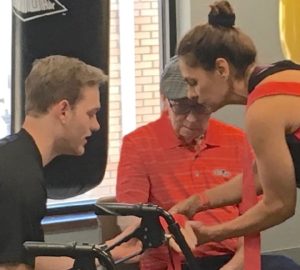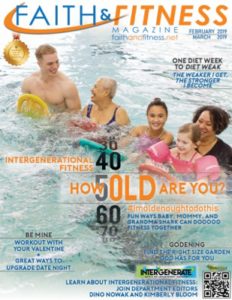 Accompaniment encourages us to crisscross the borders of age and become infused with a deepened sense of connection – actively living alongside each other.
Accompaniment encourages us to crisscross the borders of age and become infused with a deepened sense of connection – actively living alongside each other.
PUBLISHER’S NOTE: This article is primarily an excerpt adapted from Linda Staats chapter in the book InterGenerate, Transforming Churches through Intergenerational Ministry. In it, Linda, the developer of Home Grown Faith introduces readers to the concept of “accompaniment”, which is an approach to ministry and missions within the Evangelical Lutheran Church in America. She then correlates it to intergenerational ministry. As I read it, I found it to be spot-on for fitness ministry and in general as a solid basis for how Christians can approach intergenerational fitness. The visual of “Alongside Each Other” in her title is exactly the image we can create and faithfully bring to life in fitness, recreation and wellness environments. Read and digest what she shares. Then near the end I offer a few specifics on how you can apply the wisdom of accompaniment to the fitness lifestyle.
Selections from “Walking beside Each Other” by Linda Staats from InterGenerate: Transforming Churches through Intergenerational Ministry. Copyright © 2018 by Holly Catterton Allen. Used by permission of Abilene Christian University Press.
In 2009, I began leading workshops on intergenerational ministry as one expression of the newly created Glocal Gatherings. The focus of a Glocal Gathering is introducing the concept of “accompaniment,” a lens and foundation for ministry and mission. Accompaniment is the practice of “walking beside the other,” as Christ walks beside us, for the purpose of restoration and reconciliation within our communities (local) and the world (global) (2 Cor. 5:11–21).
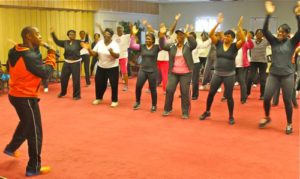 Ministry viewed through the lens of accompaniment encourages us to crisscross and connect the borders of age and stage that separate us—right here and right now, within our churches. In doing so, our congregations and households become infused with a new perspective, a deepened sense of urgency and connection with one another, locally and globally. A congregation’s potential to bring the generations together is tapped as they accompany and engage one another in the ministry and mission of sharing the good news of Jesus Christ and.
Ministry viewed through the lens of accompaniment encourages us to crisscross and connect the borders of age and stage that separate us—right here and right now, within our churches. In doing so, our congregations and households become infused with a new perspective, a deepened sense of urgency and connection with one another, locally and globally. A congregation’s potential to bring the generations together is tapped as they accompany and engage one another in the ministry and mission of sharing the good news of Jesus Christ and.
ACCOMPANIMENT: VALUES
Living alongside each other begins with sharing some common values. The journey of accompanying one another across generations begins when we recognize and commit to five intertwined values in our relationships:
VULNERABILITY
Vulnerability is opening ourselves up to God’s reconciliation in our relationships. Being vulnerable helps us face our suspicions and stereotypes of “the other.” In our culture, vulnerability often means weakness, but Jesus shows us that vulnerability is an openness to giving up control and power.
 MUTUALITY
MUTUALITY
Mutuality is built upon trust with one another. Mutuality is offering thoughtful care and working toward deeper relationships because we value another’s well-being, just as we value our own. Proclaiming and living out the gospel of Christ requires time and patience as we make plans and decisions—together.
INCLUSIVITY
In accompanying one another, we look to see who is excluded, why, and by whom. All communities exclude someone. Inclusivity means we commit to including those who are being left out. We ask ourselves, “Who is a part of our community? Who is absent? Why?”
 SUSTAINABILITY
SUSTAINABILITY
In cross-generational ministry, sustainability means establishing long-term, authentic relationships between individuals of different generations or ages. Sustainability means we recognize that any given relationship will require tending to sustain it.
EMPOWERMENT
We engage in empowerment when we recognize that relationships often have an imbalance of power and when we struggle to balance and correct those asymmetries. Sometimes empowerment will mean that the person or ministry partner with the most power steps back so that the less powerful one has a chance to shine; or that the more powerful person will work to increase the influence and authority of the less powerful.
Timothy was still a young person, possibly a teenager, when Paul recognized his gifts and encouraged him to lead. Timothy learned by experience and with guidance from a wise elder who empowered him and mentored him. It was accompaniment at its best.
ACCOMPANIMENT: ACTION
Living alongside each other produces real and lasting results. The ministry of accompaniment bears fruit when our actions are based on:
MUTUAL AND THOUGHTFUL DECISION-MAKING
We practice thoughtful decision-making when we take seriously the needs of all who will be affected—when we work to hear all voices, paying special attention to the voices of those who are frail, vulnerable, or unable to be “at” church, are home-bound, in college, at work, in prison, or committed care-givers to another generation.
SHARING RESOURCES
[For a Christian] to truly be the body of Christ, one needs to think carefully about how to share resources and receive resources in a way that respects every age and doesn’t limit the contributions and gifts of the other. Resources include opportunities, access to decision-makers, education, family connections, property, facilities, time, money, knowledge, and life experience.
RECOGNIZING EXPERTISE
Regardless of age, everyone is a teacher and learner. Every believer is gifted by virtue of their baptism and being one of God’s creations. Expertise recognition across generations can be as simple as asking everyone—from age three to one hundred and three—“What is something you are able to do or knowledge you have that you can teach or share with another?” Follow this question with, “What is something you want to learn how to do or to learn more about?” How could this question and exercise give birth to new collaborative, cross-generational ministries?
In the story of David and Goliath, we learn from King Saul’s attempt to be supportive of this young person that God had already given David everything he needed to answer God’s call and fulfill God’s mission. We are fellow workers and servants in the kingdom.
TELLING STORIES
Storytelling means recognizing God’s story is already present—in the other and in their story. Storytelling means creating time and space for sharing and receiving one another’s stories. Storytelling across generations is recognizing that each individual’s story is shaped by one’s life experience and by his or her time and place in history. Storytelling is a very active way of living alongside each other.
Don’t interact with others from the perspective, “God’s story is on my side, and you are on the other side. I’m crossing boundaries to bring God to you.”
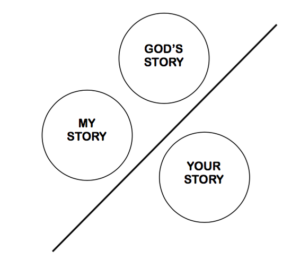
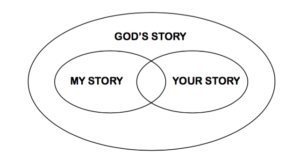
– Graphics from ELCA.org and text from the downloadable Accompaniment PDF.
Accompaniment happens when we exchange stories, expecting our perception of “the other” to change and for respect to grow. Exchanging stories contributes to a community’s shared identity.
BUILDING NETWORKS ACROSS BORDERS OF AGE AND STAGE IN LIFE
Network building is creating trusted relationships across generations. Network building breaks down segregation and division created by age. is is critical if we are to nurture and pass on our faith and build a sustainable faith community.
ACCOMPANIMENT: HOW YOU CAN DO INTERGENERATIONAL FITNESS
To bring a mindset of accompaniment to your gym, studio, church fitness facility, group exercise, recreational activity or other wellness experience begin by identifying WHO can accompany you. This is one of the basic principles of others-mindedness.
The first step toward living alongside each other is SEEING who is beside you. Initially if you’re already exercising alone, then literally look to those around you. Group fitness presupposes interaction and may be your easiest first step. Casual conversations like asking a question, requesting help, offering a compliment or suggesting a fitness tip or resource can be ways to connect with others doing solitary exercise. Gym leadership committed to intergenerational fitness accompaniment will promote it, offer ways for members to connect, identify and vet interest and make introductions.
ACCOMPANIMENT VALUES IN FITNESS
Vulnerability is a naturally shared feeling in the fitness environment on many levels. Inexperienced and overweight people, or for that matter anyone who is self-conscious will be impacted by the concerns they have of what others think (real or perceived). From the locker room to the weight room, pool or group ex class, those around you feel vulnerable. When people fail to perform to their own expectations they fell vulnerable. You can make the difference in how they deal with these feelings.
Mutuality can help you focus on the wellbeing of others. It’s that simple. A smile, a “God bless you”, another high-five can only go so far. Living alongside each other means being attentive and looking for opportunities to go further. Take time to demonstrate real help to others.
Inclusivity often begins with the fitness facility’s leadership first. They are the ones who can intentionally market to those with disabilities [and movement disorders], health needs, economic differences, ethnic diversity and of course those from various age ranges. The opportunity then moves to the members to reach beyond their familiar and make new friends.
Sustainability is again what should be a natural value in a fitness environment. Every gym and every gym member wants to move the fitness needle from ‘no-commitment’ to making it a celebrated lifestyle. Intergenerational relationships may be one of the most powerful tools in driving sustainability.
Empowerment can be beautifully nurtured and expressed through shared fitness activities. Everybody can learn from everybody. We all have something to share. Christians can apply the Bible instruction of “hunger and thirst for righteousness” to how they connect with others. An insatiable desire to gain wisdom and value interaction is what fuels empowerment.
ACCOMPANIMENT ACTION IN FITNESS
Review the approaches to action above that Linda shares. Again, they naturally fit into how you can do intergenerational fitness. Use the Facebook Comment space below to share on this page and on your Facebook page your ideas on how you can put accompaniment into action in the fitness you do.
HELP FOR LIVING ALONGSIDE EACH OTHER
For help with bringing accompaniment and intergenerational fitness to your community.
Read more from the February/March 2019 issue of Faith & Fitness Magazine to get more ideas on living alongside each other.






